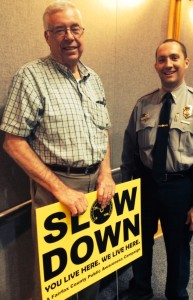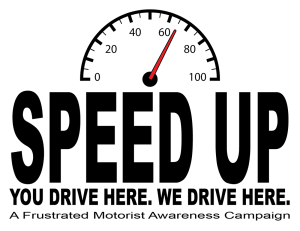
In August of last year, the Fairfax County Police Department (FCPD) started a patronizing ‘slow down’ campaign intended to get people to stop speeding through neighborhoods. In and of itself, I’m fine with low speed limits on residential streets, and I’m fine with tough enforcement of those low speed limits. I am not, however, okay with setting residential-style low speed limits on major arterial thoroughfares.
Not long after FCPD launched their campaign, yellow signs (like the one to the right) started cropping up all over the place . . . and on all kinds of roads, not just on residential streets. Some major thoroughfares have speed limits set far below the road’s 85th percentile speed, which is the ‘proper’ limit recommended by most traffic engineers, and this patronizing yellow sign has started cropping up on them too. One glaring example is Braddock Road heading west from Route 28. It has an absurdly low 35 mile-per-hour limit, despite being a major thoroughfare that could easily and safely accommodate 45 or higher . . . and now it has lots of yellow signs in people’s yards.
Braddock is indeed lined with houses, but you can’t move into a house on a major suburban-to-rural thoroughfare and expect that everybody will start treating that thoroughfare like it’s a cul-de-sac. That’s not how it works. If you move into a house that abuts a major arterial road, then fast moving traffic is just something you are going to have to deal with. If you didn’t like the idea of living on a major thoroughfare, well, maybe you should have moved to one of the cul-de-sacs around the corner instead.
When it comes to speed, people tend not to look beyond the headlines. They hear about crashes where ‘excessive speed was a factor,’ or cases where a child ran out into a road and was seriously hurt or even killed. But we seem to forget that those ‘excessive speed’ accidents involve people going 60 in a 25, or 80 in a 55. Most drivers are not so reckless; those that are will ignore the speed limits no matter what they are. We also forget that the best way for a child to avoid getting hit by a car is not to slow down everybody on the road, but to teach the child how to look both ways before crossing, and to supervise them properly. And don’t forget that our ‘standard’ speed limits (25 residential, 35 feeder, 45 arterial, 55 highway) were set in the 1950s and ’60s . . . when stopping distances were much longer and cars were much less maneuverable. A modern vehicle can come to a stop from 60 faster than many 1950s cars could stop from 30. And a crash at 70 is more survivable today than a crash at 50 was just a few short decades ago, thanks to incredible improvements in automotive safety. Maybe it is time to reevaluate our standards.
And why does it matter? Because badly set speed limits have real world costs. They are difficult to quantify in the way that we can quantify traffic deaths or ‘speed related’ accidents, but they are no less real. How many people drive Braddock Road in a day? Probably thousands. And if we can save thousands of people even five minutes in their day, we have made a small but real improvement to their quality of life. And appropriate speed limits also reduce speed disparity (the difference in speed between the ‘goody two shoes’ driving at the limit and people like me who drive at the highest safe speed for the road and the conditions) . . . and reducing speed disparity has been shown to significantly reduce accidents, road rage, traffic tie-ups, and driver stress. Michigan learned this when they began requiring that speed limits in the state be set on the basis of sound traffic engineering rather than revenue concerns; the limits went up, and accidents and tie-ups went down.
So, with all of this in mind, I designed my own sign in a similar style to the one that Fairfax County has been producing. Let me know what you think. . . .

Download a PDF of the sign, if you would like to print your own!
